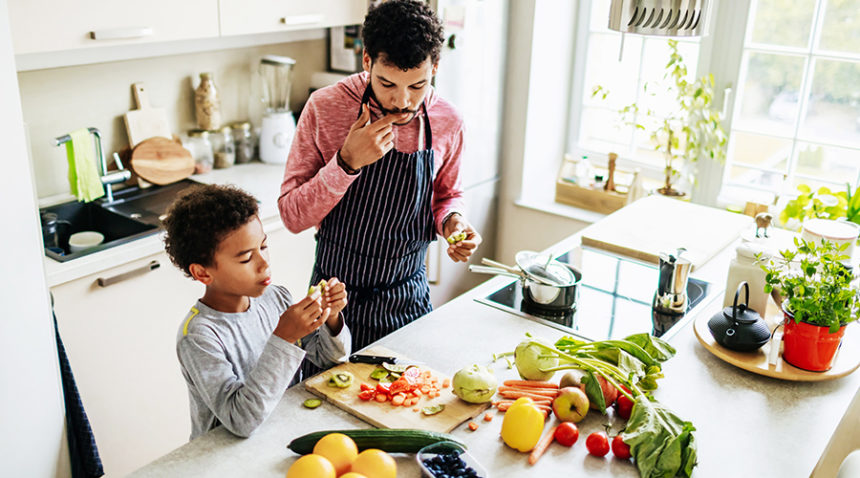If someone told you to eat more plants, would you imagine a menu of bland salad after bland salad? Don’t—getting more plants in your diet can be colorful and tasty.
A plant-based diet is one that is made up of foods primarily from plants including vegetables, whole grains, fruits, beans, lentils, nuts and seeds. It has been shown to have numerous health benefits including helping to control heart disease, diabetes, some types of cancer, mild depression and improved mental function in older adults, UNC Health dietitian Shelly Wegman says.
“The reason plant-based foods are so beneficial is because you really get a lot of nutritional bang for your buck,” Wegman says.
“They tend to have certain kinds of fiber that bind with cholesterol and help your body get rid of it. The fiber also helps control blood sugars. Plant-based foods have a lot of vitamins, minerals and phytochemicals, which are little bioactive chemicals that protect and repair at the cellular level.”
With a plant-based diet, you need few supplements because you’re getting a lot more vitamins and minerals from what you eat, compared with a diet of processed foods and few fruits, vegetables and whole grains, Wegman says.
Here are six tips for adding more plant-based foods to your diet, whether you want a diet of only plant-based foods—vegetarian or vegan—or you just want to eat more plants.
1. Make plant-based foods the main attraction on your plate.
If you want to add more plant-based foods but you’re not ready to give up meat, you can start by making meat a smaller portion of your plate.
“Make that the side dish and make the plant-based foods the star of the meal,” Wegman says. “Half the plate could be a combination of vegetables. A quarter of the plate is the protein from meat. And then the other quarter of the plate would be fruits and whole grains to get in your carbohydrate sources.”
For example, if you normally fill your plate with the largest piece of chicken right in the center, try choosing a smaller piece that only takes up about a quarter of the plate. Use another quarter of the plate for a side of brown rice. Then you’ve got half the plate for any combination of vegetables: carrots, green beans, broccoli, asparagus, cauliflower—the possibilities are endless.
2. Make a dish that combines multiple vegetables and grains.
Think about dishes you already know how to cook. Is there a way to add more vegetables and whole grains?
Wegman suggests two dishes that pack a ton of plant punch: Quinoa salad with black or kidney beans and a variety of vegetables (roasted peppers, onions and tomatoes) or a stuffed portabella mushroom with white beans and spinach.
“You get a lot of different nutrients in that serving of food,” Wegman says. “You’ve now got beans and two different vegetables in there.”
3. Dress up a salad.
Instead of a basic salad with lettuce, tomatoes and dressing, aim to use a rainbow of vegetables and fruits. You also can buy more than one variety of lettuce to add nutrients and taste. Almonds, pumpkin seeds and sesame seeds make great salad toppers.
“Add in different things that you like, and then throw in some raisins, dried fruit, nuts or seeds to top it off,” Wegman says.
4. Make fruits and vegetables part of snack time.
To help yourself eat fruits and vegetables as snacks, make them easy to serve and tasty. Try a fruit skewer (a variety of little pieces of fruit on a stick) with a cinnamon yogurt dip. Or make caprese salad skewers with a cherry tomato, fresh basil, a little piece of romaine lettuce and part of a mozzarella ball.
“The caprese salad skewers make great appetizers, too,” Wegman says. “It’s not just chips and dip or cheese and crackers that you can set out; you can serve a lot of different colorful fruits and vegetables.”
A kid-friendly combo is apple slices with peanut butter or any nut butter. Or try celery stuffed with roasted pepper hummus or guacamole and sprinkle some sesame or pumpkin seeds on it.
“You can do a whole-grain pita and have the kids decorate it,” Wegman says. “Cut it in half, put a little tomato sauce on it or smear a hummus, and then have the kids decorate it with vegetables and a sprinkle of cheese and pop it under the broiler. That gets the kids invested in their food choices.”
5. Grill fruits and vegetables with your meat or fish.
Leave space on your grill for fruits and vegetables.
“Grilled romaine lettuce with a splash of fresh lemon juice is amazing,” Wegman says. “And you can grill a lot of different fruits, such as grilled peaches or grilled pineapple. It’s a way to bring something extra to a dish.”
For example, if you’re having fish, you can make a grilled pineapple salsa to go with it.
“What better way to dress it up, make it colorful, and get in those extra vitamins and minerals?” Wegman says.
6. Use lots of vegetables when making a sauce.
Add vegetables to your diet via sauces, such as fruit or tomato salsas. Or try a romesco sauce, which is nuts with roasted red peppers pureed together, or a basic basil pesto sauce.
“You can use these plant-based sauces on all sorts of things, from pasta and greens to fish and seafood and chicken,” Wegman says. “It’s an extra way to get those vitamins and minerals to help your body.”
Want to schedule an appointment with a dietitian? Contact Rex Wellness Centers or UNC Wellness Centers.

